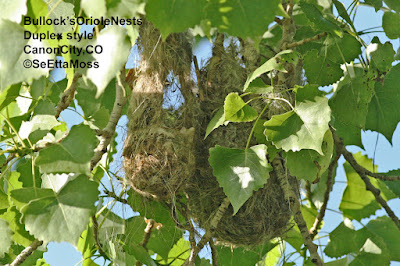W Kingbird's unusual nest location

Today I found a Western Kingbird nesting above an old oriole nest. This pair of kingbirds lost a prior nest a few weeks ago when it was blown off a utility pole, a common location for their nests in this area. They apparently built their new nest on top of the old oriole nest that has not been occupied by Bullock Orioles this year. This may be a good strategy since the old nest has survived a year in good condition. The top pic shows the full oriole nest made with some colorful string, a common thing with Bullock Oriole nests. I think the kingbirds may have enlarged the top of the oriole nest to better accommodate their nest. The kingbird's bill is prominent in the pics. Her white throat and her left eye can also be seen. And her tail is visible sticking out of the nest to the left side. Very innovative birds. SeEtta


